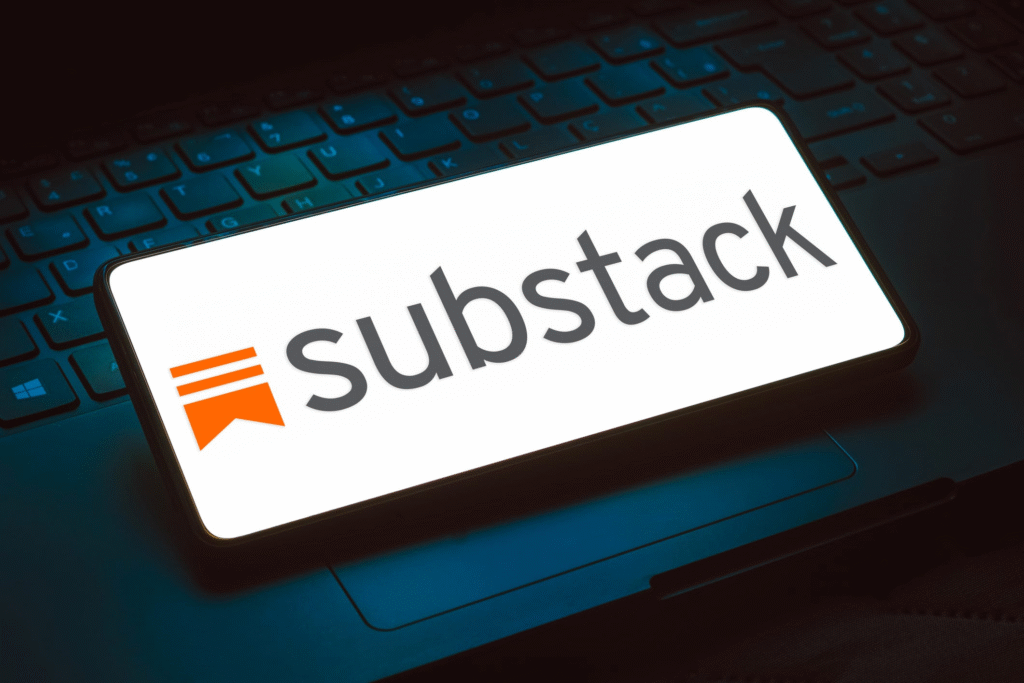Have you ever wondered if you can really make money on Substack without thousands of subscribers? You’re not alone. In 2025, more creators than ever are turning newsletters into real income streams—even small ones.
This in-depth guide shows you exactly how to turn your writing into up to $3,500/month (or more) with multiple income sources. You’ll learn what works, what doesn’t, and how everyday writers are earning sustainably.
Whether you’re starting from zero or ready to monetize, this post lays out every strategy—backed by real success stories and simple step-by-step actions.
Key Takeaways
- Multiple Monetization Methods Exist – Substack supports paid subscriptions, sponsorships, affiliate links, digital products, and even tips or consulting income.
- You Don’t Need a Huge Audience – Even with just 100–200 loyal readers, you can create real monthly revenue through niche targeting and diversified income.
- Free First, Paid Later Works Best – Start with free content to build trust, then roll out paid tiers with bonus value (e.g., exclusive posts, AMAs, or audio).
- Creative Extras Boost Conversion – Readers love value-adds like Q&A posts, downloadable tools, and premium community access (e.g., Slack groups or templates).
- Substack Takes a Cut – The platform charges a 10% fee + Stripe processing, so it’s smart to set pricing accordingly and plan for net income.
How to Make Money on Substack?
Making money on Substack is easier than ever—if you approach it with strategy. Writers no longer need massive audiences. In fact, many successful creators are earning a few hundred to several thousand dollars per month with just a few hundred subscribers.
The key is focusing on value. People will pay for newsletters that solve a problem, entertain, or give insider insight. A clear niche, consistent publishing, and smart pricing unlocks your earning potential—even without ads or clickbait.
It’s also a low-barrier platform. Substack handles tech, email delivery, and payments for you. That means all you need is an idea, a little writing discipline, and a plan to grow. If you stay consistent and experiment, real earnings aren’t just possible—they’re predictable.
What do you need to get started?
To start making money on Substack, all you need is a free Substack account, a clearly defined topic, and a few posts. While there’s no follower minimum, you’ll want to build an audience through platforms like X (formerly Twitter), LinkedIn, or Threads. You’ll also need a Stripe account for payments, and ideally, a content calendar. Publishing weekly is a strong start for audience growth and trust.
How much money you can make on Substack?
Earnings vary based on your audience, pricing, and monetization methods. A single writer with 200 paying subscribers at $5/month could make $1,000/month (before fees). Those with premium communities or digital product sales earn even more.
One creator, Burk, shared he earns consistently from five streams: subscriptions, sponsorships, affiliate links, digital product sales, and reader tips—without a huge list. He emphasized that it’s the combination of small earnings from each that creates a solid income stream. Others report making $2,000–$4,000/month with under 2,000 subscribers.
18 proven Strategies to Make Money on Substack
Whether you’re an indie writer building a loyal readership or a brand monetizing thought leadership, these 18 proven strategies show exactly how to make money on Substack—from subscriptions and sponsors to affiliates, digital products, and more.
1. Paid Subscriptions

This is the most popular and straightforward way to make money on Substack. Substack allows writers to put part or all of their content behind a paywall, charging subscribers monthly or annually. You can choose what content is free and what’s exclusive to paying readers.
Many successful creators recommend starting with free content first to build trust. Then, introduce a paid tier with additional value: exclusive articles, behind-the-scenes insights, audio versions, Q&As, or early access. Pricing is usually $5/month or $50/year, with some premium tiers offering more benefits.
The best part? You keep your audience in one place while creating recurring revenue from even a small list of loyal readers.
How to Set Up Paid Subscriptions on Substack?
- Create a free Substack account and publish at least 3–5 quality free posts
- Go to Settings → Payments, then connect your Stripe account
- Set your pricing: $5/month and $50/year is standard
- Toggle “Enable Paid Subscriptions” in your dashboard
- Decide which posts are free and which are paid
- Offer incentives like bonus posts, downloads, or private AMAs
- Announce your paid tier to your readers with a launch post
- Consistently publish valuable content to reduce churn
- Monitor open rates and subscriber retention monthly
- Adjust pricing or frequency based on reader feedback
Quick Tip: Make your paid offer irresistible with exclusive formats like audio letters or private “insider” essays.
2. Sponsorships
As your newsletter grows—even into the low hundreds—brand partnerships can become a viable revenue stream. Substack newsletters are known for highly engaged audiences, which advertisers value more than raw reach.
Sponsorships usually involve a short paragraph or image within your email, showcasing a product or service that fits your niche. Authenticity is key: choose partners that your readers would actually find useful or interesting.
Many creators use these as one-off placements, while others build long-term sponsor relationships that pay per post or month.
How to Add Sponsorships on Substack?
- Define your audience’s interests and purchasing behavior
- Create a “sponsor kit” with pricing and newsletter stats (open rate, audience size, niche)
- Reach out to relevant brands or use platforms like Passionfroot or Swapstack
- Negotiate price-per-post, usually starting at $50–$150 per 1,000 subscribers
- Offer options: solo ad, “sponsored by” mention, or dedicated newsletter
- Place the ad within natural breaks (e.g., after intro or before your main content)
- Use trackable links to monitor click-through rates
- Always disclose sponsorships transparently to build reader trust
- Ask readers for feedback—keep ad tone conversational
- Limit frequency (1–2 sponsors/month) to avoid reader fatigue
Quick Tip: Choose sponsors who align deeply with your topic to maximize conversions and maintain authenticity.
3. Affiliate Links
Affiliate marketing works surprisingly well in newsletters—especially when you recommend tools, books, or resources you genuinely use. You earn a commission every time a reader makes a purchase through your special referral link.
Unlike sponsorships, affiliates don’t require brand outreach. You just sign up for a program, embed the link, and let your content do the rest. Done right, this can provide passive income on top of your other methods.
It works best when paired with product reviews, tutorials, or resource roundups.
How to Use Affiliate Links on Substack?
- Join affiliate platforms like Amazon Associates, Gumroad, ShareASale, or Impact
- Identify products or services relevant to your audience (e.g., writing tools, books)
- Write a post or newsletter that naturally includes your affiliate links
- Always disclose affiliate partnerships clearly
- Use shorteners like Bit.ly or Pretty Links for cleaner links
- Track performance and clicks using Substack’s built-in analytics or external tools
- Don’t overuse—limit to 1–2 links per newsletter for credibility
- Include personal anecdotes or results when mentioning products
- Test and compare different programs to find best payouts
- Refresh outdated links regularly
Quick Tip: Add a monthly “Tools I Love” roundup to boost affiliate earnings with consistent, helpful content.
4. Sell Digital Products

Many creators extend their Substack income by selling e-books, templates, guides, or courses. These products are low-overhead and can be delivered instantly via email or a Gumroad/Payhip link.
Substack doesn’t natively support digital product checkout, but you can use Sidestack, Gumroad, or even Stripe links in your posts or welcome emails to sell directly.
You don’t need to be a designer—just package up your knowledge in a clear, helpful format and share it with readers.
How to Sell Digital Products on Substack?
- Choose a product idea: e.g., “Freelance Pitching Templates” or “30-Day Newsletter Starter Plan”
- Create your product using tools like Canva, Google Docs, or Notion
- Host it on Gumroad, Payhip, or via Sidestack embed
- Announce your product via a launch post or special email
- Offer a special subscriber discount to paid members
- Add call-to-actions at the end of relevant newsletters
- Include testimonials or preview screenshots
- Create a dedicated “Shop” page if you have a personal website
- Update the product regularly for ongoing value
- Promote during relevant seasonal or themed content
Quick Tip: Build products based on your most-viewed or most-asked-about newsletter topics.
5. Offer Consulting or Coaching

Once you’re seen as an expert in your niche, readers may want 1:1 help. Consulting and coaching are powerful high-ticket offerings that don’t require a large subscriber base—just authority and trust.
Whether you help people start their own Substack, improve writing, or grow their audience, you can charge hourly, monthly, or per project.
How to Offer Consulting on Substack?
- Clarify your niche and what you can teach or solve
- Add a “Work With Me” section to your Substack bio or about page
- Offer a free consult or Q&A to generate interest
- Use tools like Calendly and Stripe for scheduling and payment
- Announce openings in your newsletter
- Create case studies to showcase past results
- Limit your time slots for exclusivity
- Offer packages (e.g., 3 calls/month) to stabilize income
- Include a booking link in welcome emails for new subscribers
- Follow up with testimonials for social proof
Quick Tip: Start with beta clients from your own audience to refine your process and pricing.
6. Create a Premium Community
Substack now allows integration with Discord and other platforms to create paid, private communities for your biggest fans. These communities can include live chats, video calls, peer support, and exclusive content drops.
This method boosts both engagement and retention while adding a premium layer to your newsletter.
How to Launch a Premium Community on Substack?
- Choose a platform: Discord, Slack, Circle, or Geneva
- Create your community structure (channels, rules, exclusive events)
- Set expectations: weekly discussions, AMAs, private feedback
- Add access to your top paid tier (e.g., $15–$20/month)
- Introduce it via a dedicated post and FAQ page
- Offer founding member discounts or limited invites
- Moderate regularly and spark discussions
- Host exclusive Zoom Q&As or live writing sprints
- Celebrate member wins and participation
- Survey members quarterly for feature ideas
Quick Tip: Limit group size early on to increase perceived value and deepen interaction.
7. Accept Reader Tips
Don’t underestimate reader generosity. Even if you offer free content, loyal readers often want to support you. Substack doesn’t have built-in tipping (yet), but you can link to Ko-fi, Buy Me a Coffee, or PayPal in your posts.
This method works well when you have a growing but unpaid list.
How to Collect Tips on Substack?
- Set up a Ko-fi or Buy Me a Coffee account
- Add your tip link to your Substack bio and post footers
- Occasionally remind readers in your content (“If you enjoyed this, consider buying me a coffee!”)
- Use emojis and friendly tone to keep it light
- Thank tippers publicly (with permission)
- Offer tip-based incentives like bonus downloads or shoutouts
- Create a pinned “Support My Work” post
- Include a tip link in welcome emails
- Mention tip goals occasionally (e.g., “help me buy a mic”)
- Track who tips for possible paid tier upgrades later
Quick Tip: Combine tip asks with milestones—like reaching 1,000 subscribers or publishing your 50th post.
8. Publish a Paid Newsletter Series or Mini-Course
Substack supports drip-style series—great for mini-courses or themed guides that unfold over multiple emails. These are perfect for turning knowledge into educational content that readers pay for upfront or through a higher-tier subscription.
How to Do It on Substack?
- Choose a topic: e.g., “10-Day Guide to Writing Faster”
- Map out 5–10 structured lessons or emails
- Create a paid tier that grants access to the series
- Use Substack’s “Series” feature to schedule delivery
- Promote it as an email course or learning track
- Include downloadable tools or checklists
- Add a feedback form at the end of the series
- Bundle past series for recurring revenue
- Offer discounts for early buyers
- Highlight success stories from past participants
Quick Tip: Repurpose popular posts into course-style sequences to maximize content ROI.
9. Host Sponsored Interviews or Guest Features
Interviewing thought leaders in your niche adds value—and can also be monetized. Some guests may pay to be featured if your audience is well-targeted, or you may land sponsors who fund a full “spotlight” series.
How to Monetize Guest Features on Substack?
- Pitch it as a win-win: exposure for the guest, great content for your readers
- Package guest posts or interviews into a paid series
- Offer guests a chance to sponsor the post
- Include affiliate links in the guest’s tools/resources
- Promote via cross-posting on the guest’s channels
- Include transcripts or downloadable summaries for paid subs
- Gate full interviews behind paywalls
- Keep branding subtle and consistent
- Use repeat guests to build series momentum
- Track reads and shares to showcase performance
Quick Tip: Focus on guests with overlapping audiences who are excited to promote the interview.
10. License Content to Brands or Publications

Once you’ve built a strong library of original writing, you can license past content to companies, blogs, or media outlets. This is a lesser-known method, but highly effective for long-form writers with evergreen material.
How to License Content on Substack?
- Identify your most valuable posts with evergreen insight
- Reach out to brands in adjacent industries (SaaS, consulting, etc.)
- Offer republishing rights or white-label versions
- Create licensing packages (1-time use or monthly retainer)
- Set clear use-case limits (e.g., internal training, blog repost)
- Include licensing rights in your media kit
- Use platforms like Contently or ClearVoice if needed
- Offer bundled packages of 3–5 pieces
- Protect IP with clear contracts
- Track how your work is used for future referrals
Quick Tip: Start with brands that already follow or engage with your newsletter.
11. Host Paid Webinars or Live Trainings
Substack doesn’t offer built-in webinar hosting, but many writers use Zoom or Crowdcast to run live trainings. You can charge readers for access or offer webinars as part of your paid subscription tier.
Live sessions work especially well for teaching skills, answering questions, or coaching in real time. Once recorded, you can repurpose the webinar as an evergreen bonus for new paid subscribers.
Quick Tip: Promote webinars 7–10 days in advance and cap attendance to create urgency and exclusivity.
12. Publish a Substack-Only eBook
Writers often use their newsletters as launchpads for eBooks. You can compile your best posts into a single resource, polish it, and sell it directly to your readers.
Many creators use Gumroad or direct Stripe links and offer it as a thank-you to supporters. You could even serialize the eBook and drip it weekly through your newsletter.
Quick Tip: Add a “Buy My Book” link in your Substack navigation bar or footer for consistent visibility.
13. Offer Brand or Creator Audits
If you’ve built authority in a niche—like writing, branding, or productivity—you can offer paid audits for individuals or companies.
These typically involve reviewing a newsletter, brand voice, or workflow and providing customized feedback. Since it’s 1:1 work, pricing can start at $100–$300 per audit, even with a small list.
Quick Tip: Showcase a sample audit in a post to help readers understand what they’ll receive when they book.
14. Curate a Niche Job or Opportunity Board
If your Substack focuses on a specific industry—like writing, design, or startups—you can create a job board that your readers pay to access or submit to. Use Notion, Airtable, or Substack’s notes to manage posts. This works well for communities that want exclusive, vetted listings.
Quick Tip: Let sponsors post premium listings for a fee and include those in a weekly roundup email.
15. Launch a “Founding Member” Program
When you’re just starting a paid tier, offering a “Founding Member” level (often $100–$250/year) is a great way to raise initial revenue.
Founding Members get extra perks—like 1:1 calls, shoutouts, or lifetime discounts—and help support your long-term work. This model has been used by many Substack writers during their first monetization push.
Quick Tip: Limit founding spots to 10–25 people to make it exclusive and easier to fulfill added benefits.
16. Sell Ad Space in Your Archives

Your Substack archive becomes valuable as your readership grows. Older high-performing posts can be lightly edited to include paid mentions, affiliate links, or retroactive sponsorships. This repurposing method earns from existing traffic, especially if posts are still being discovered via search or social shares.
Quick Tip: Re-share archived posts on Threads or X and monitor which ones get the most new traffic.
17. Add a Tip Jar to Your Welcome Email
Your welcome email is often the most-read message you’ll ever send. By placing a tip jar link (e.g., Ko-fi or Buy Me a Coffee) there—alongside your story and best content—new readers get a chance to show support right away. It’s a passive but effective strategy that works even before you launch paid tiers.
Quick Tip: Write a personal welcome story that makes readers feel emotionally invested in your mission or journey.
18. Create a Niche Resource Directory
If you’re an expert or well-connected in a certain field, compile a resource directory (e.g., tools, vendors, blogs) and offer it as a paid PDF, private link, or membership perk. This works particularly well in B2B, freelance, and creator niches. It requires upfront effort but can be sold or bundled long-term.
Quick Tip: Use Airtable or Notion to build the directory and update it monthly to keep value high.
Step-by-Step Guide to Make Money on Substack
Step 1: Create Your Free Substack Account
Start by signing up at Substack.com. It’s free, beginner-friendly, and doesn’t require tech skills. You’ll choose a title, URL, and short description for your newsletter. Don’t overthink it—just pick something related to your topic or personal brand. Once you’ve registered, you’ll have a homepage, publishing dashboard, and mailing list all set up automatically.
Step 2: Choose a Clear Niche and Reader Promise
To make money, you need a loyal audience—and that means being specific. Define your niche by asking: What value do I consistently provide? Whether it’s storytelling, marketing tips, or freelance advice, your reader should immediately understand why they should subscribe. A clear focus makes it easier to attract, convert, and retain paid subscribers.
Step 3: Publish Free, High-Value Content Weekly
Before charging money, build trust by offering consistent free content. Publishing once a week is ideal. Focus on providing insight, solving problems, or entertaining in your niche. Include a call-to-action to subscribe at the bottom of every post. Use Substack’s built-in analytics to monitor what’s resonating most with your audience.
Step 4: Connect Your Stripe Account and Set Prices
Once you’ve posted 3–5 high-quality free issues, you’re ready to monetize. Go to Settings → Payments and connect Stripe. Then, set your subscription prices—$5/month and $50/year are standard. You can also enable a “Founding Member” tier ($100–$250/year) for your most loyal readers.
Step 5: Announce Your Paid Tier with Value Bonuses
Now introduce your paid subscription tier with a dedicated announcement post. Explain what paid readers get—like bonus posts, AMA access, a private podcast, or digital downloads. Use a personal tone and include early-bird pricing or limited-time offers. The goal is to convert your free list without sounding overly salesy.
Step 6: Promote Across Platforms to Grow Your List
Share your Substack on platforms like X (Twitter), LinkedIn, or Threads where your audience hangs out. Collaborate with other newsletters, do guest posts, or participate in Substack’s own discovery network. Traffic is the fuel of monetization—so consistently grow your audience alongside your content.
Step 7: Layer in Affiliate Links and Sponsorships
As your list grows, diversify your revenue. Add authentic affiliate links to tools or books you recommend, and start pitching relevant brands for small sponsorships. Even newsletters with 500–1,000 readers can attract paid placements.
Step 8: Launch a Digital Product or Paid Series
Use your existing content or expertise to create an eBook, PDF guide, or a mini-course delivered by email. Sell it via Gumroad, Sidestack, or directly with Stripe links. These one-time purchases complement your subscription income and provide value beyond the inbox.
Step 9: Add Advanced Offers Like Coaching or Premium Communities
Once your reputation and list grow, offer higher-priced services. These might include 1:1 coaching, subscriber-only Discord groups, or personalized audits. These methods don’t require a huge audience, just trust and proof of your value.
Step 10: Monitor, Optimize, and Keep Showing Up
Check analytics monthly: open rates, click rates, unsubscribes, and paid conversions. Test different post formats, headlines, and email subject lines. Above all, keep publishing—even slow starts can snowball into $2K–$4K/month newsletters with patience and persistence.
Tips to Increase Revenue on Substack
If you’re already monetizing, there are several proven ways to increase earnings without overwhelming your audience.
First, test different price points. Try offering a Founding Member tier ($100–$250/year) for superfans. This can significantly raise average revenue per user. Include perks like a 1:1 call, shoutout, or exclusive eBook.
Second, bundle offers. Combine your paid newsletter with a digital product or exclusive invite to a private community. Readers love layered value, especially if it feels exclusive.
Third, reduce churn. Send consistent reminders of what paid subscribers are getting—bonus posts, behind-the-scenes, early access. Engaged readers stick around longer.
Finally, promote your Substack in more places. Use X (Twitter), LinkedIn, podcast guesting, and Substack cross-promotions. The more targeted traffic you bring in, the more conversions you’ll see.
Best AI Tools for Substack Writers
Using AI tools can streamline your content creation and boost productivity—especially if you’re managing multiple monetization streams.
ChatGPT and Claude can help you generate outlines, brainstorm content ideas, or rewrite headlines for better engagement. These tools are especially useful when you’re stuck or need fast content batches.
Grammarly or ProWritingAid polish your grammar and tone, so your writing sounds pro-grade. Tools like Quillbot can paraphrase complex ideas into simpler, clearer language—perfect for newsletters aimed at beginners.
If you’re producing audio versions of your newsletters, tools like Descript can record, edit, and publish podcasts in one place.
Writers building digital products or lead magnets can use Canva or Tome AI to design PDFs or presentations.
Quick Tip: Save your favorite AI templates so you can repurpose successful formats across multiple posts.
Best Affiliate Platforms for Substack Writers
If affiliate marketing is part of your monetization plan, choosing the right platforms is key to maximizing earnings while maintaining reader trust.
Gumroad and ConvertKit Commerce work great for selling creator-made tools, courses, or templates. You can earn 10–30% commissions by referring other writers or creators.
Amazon Associates is easy to use for book recommendations, office gear, or digital tools. It’s a smart fit for lifestyle, tech, or productivity niches.
ShareASale, Impact, and PartnerStack offer thousands of affiliate programs across software, finance, education, and more. You can track clicks and commissions easily with these dashboards.
Just be sure to disclose all affiliate links transparently in your posts.
Quick Tip: Use a monthly “Tools I Love” newsletter to highlight 2–3 affiliate products in an authentic way.
Best Marketing Tools for Monetizing on Substack
Marketing your newsletter is just as important as writing it—especially if you want to grow a paying audience consistently.
For landing pages and email capture, Beehiiv and ConvertKit integrate well with Substack and can be used to build pre-launch waitlists or capture emails from multiple traffic sources.
For social media promotion, use Hypefury or Tweet Hunter to schedule engaging Twitter/X threads. These help showcase your newsletter’s value and drive more readers in.
SparkLoop is a great referral tool that rewards current subscribers for sharing your newsletter. Combine it with limited-time offers or giveaways for rapid list growth.
Lastly, use Google Analytics to track what traffic sources are bringing the most conversions so you can double down on what works.
Quick Tip: Promote your most popular post weekly to attract new readers who convert faster than cold leads.
Conclusion
Substack is no longer just a blogging tool—it’s a full-on business platform for independent writers. By combining paid subscriptions, affiliate links, sponsorships, and digital products, you can build a newsletter that earns $1,000–$5,000/month even without a massive list.
The key is consistency, creativity, and focusing on value over volume. Whether you’re just starting or scaling up, every reader is a potential supporter.
Ready to launch? Your first $100 is closer than you think.
Frequently Asked Questions (FAQs)
How many subscribers do I need to make money on Substack?
You can start earning with as few as 100–200 engaged readers. If 5–10% convert to paid at $5/month, that’s $25–$100/month. Add affiliate links or a digital product, and your income grows fast.
What’s the best pricing for a paid Substack newsletter?
The most common is $5/month or $50/year. Founding Member tiers range from $100–$250/year. Consider your audience’s budget and content value, and always test your pricing.
Can I run a Substack anonymously and still get paid?
Yes, many writers use pen names. Just be sure your Stripe account has your real info for payment processing. Authenticity still matters—even if your face isn’t public.
How does Substack’s fee structure work?
Substack charges a 10% fee on all paid subscriptions. Stripe adds ~2.9% + $0.30 per transaction, plus a small recurring billing fee. Plan pricing to account for these cuts.
Is it better to start free or launch with paid content right away?
Always start with free content first. Build trust and an audience before offering paid content. Once people are hooked, they’ll happily pay for bonus posts or perks.
Can I move my content or list off Substack later?
Yes. Substack allows you to export both your content and email list at any time. It’s a great platform for getting started, but you can always grow beyond it.
What kind of content works best on Substack?
Content that educates, inspires, or entertains in a niche works best. Long-form essays, curated insights, and storytelling perform well—especially when tied to personal experience or value delivery.



